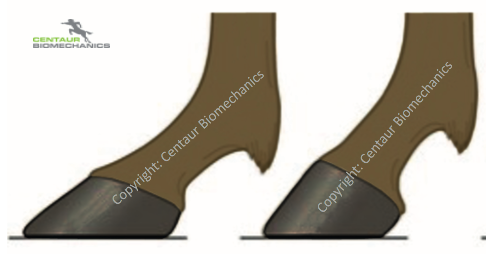
Studies have previously demonstrated that saddle slip can be related to hind limb lameness (1) and movement asymmetry (2). However, are there other factors which can influence saddle slip as well as the aforementioned? It is often thought that the rider is responsible for inducing saddle slip however, this is not currently supported by any experimental data, in contrast studies have found that the rider is not, in most cases a contributing factor (2, 3) .
An area we are currently investigating is front hoof shape and its relationship with saddle slip. In horses with uneven feet, the side with the flatter foot has been shown to have an increase in vertical ground reaction force (GRF) and a larger vertical fetlock displacement whereas the more upright foot was linearly correlated with an earlier braking-propulsion transition (4). Therefore, in horses who have uneven feet, different ground reaction forces (left-right) are present. GRFs provide gravitational support to the body and the vertical GRFs are higher in the front limbs compared to the hind limbs.
Where are these forces transmitted to? Vertebral morphology with respect to shape, size and orientation of the facet joints, largely determines movement along with soft tissues. The vertebrae of the cranial thoracic spine up to the anticlinal vertebra (~T16) modulates the forces from the forelimb, head and neck.
In respect of the saddle and rider; the saddle is positioned in the thoracic region. The lowest part of the saddle would be approximately in the region of ~T13, corresponding with the lowest part of the back. Therefore, the area of the back that the saddle and rider are positioned, is an area which is responsible for modulating forces from the forelimbs, head and neck. In cases where the front feet are asymmetric, this leads to asymmetric GRFs which will lead to asymmetric forces being applied to the body influenceing function and posture. Could this have an effect on the kinematics of the back and consequently saddle position….? This is a question we are currently investigating – from preliminary data (5) we collected from a group of horses, it appears that there is a relationship between hoof shape and saddle movement however, more studies are scheduled to investiagte this further.
Although we don’t have all the answers yet, the purpose of this blog was to further highlight the complexities of saddle fit and highlight the need for a team approach when managing horses who have saddle slip. It would be great to have a simple model of just “correcting” the rider to eliminate saddle slip or "replacing the saddle", however as said previously, this is not supported by any experimental evidence. Instead, working collectively with your qualified saddle fitter and equine/human team will help evaluate, support and manage the horse which will help to reduce / eliminate the saddle slip. As previously said, saddle fitting is complex and in the case of horses who have saddle slip the complexities are increased further.
Please like / follow our page for more blogs and please share to raise awareness.
Dr. Russell MacKechnie-Guire
Centaur Biomechanics
www.centaurbiomechanics.co.uk
#equineresearch #biomechanics #centaurbiomechanics #veterinarymedicine #equinephysiotherapy #equinetherapist #onlinecourses #onlineseminar
1. Greve L, Dyson SJ. An investigation of the relationship between hindlimb lameness and saddle slip. Equine Vet J. 2013;45(5):570-7.
2. Mackechnie-Guire R, Mackechnie-Guire, E., Fisher, M., Mathie, H., Bush, R., Pfau, T., Weller, R. Relationship between saddle and rider kinematics, horse locomotion and thoracolumbar pressures in sound horses. JEVS. 2018;69:43.52.
3. Greve L, Dyson SJ. The interrelationship of lameness, saddle slip and back shape in the general sports horse population. Equine Vet J. 2014;46(6):687-94.
4. Wiggers N, Ambrósio CE, Nauwelaerts SLP, Hobbs SJ, Bool S, Wolschrijn CF, et al. Functional Locomotor Consequences of Uneven Forefeet for Trot Symmetry in Individual Riding Horses. Plos One. 2015;10(2):e0114836.
5. MacKechnie-Guire R et al., Hoof Shape and its Relationship with Saddle Slip, Pilot Study, 2018